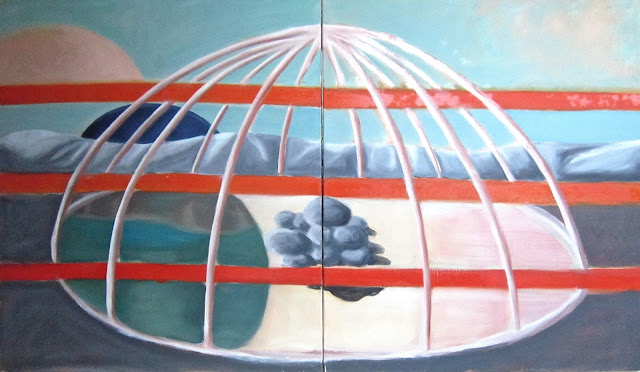STRIPES 2015 / 16
a series of paintings, that challenge historical
and digital archives as sources of citation.
a kind of battle between the analogue and the digital.
some random thoughts on STRIPES
"The
Americans" 1959 and later "The Lines of My Hands" by Robert Frank
denoted the autobiographical subject view on (American) reality of the
late 50´s and of the early and late 60´s.
Today,
we are haunted by digital collisions of layers of information, followed by voids of amnesia. The contemplation needed for abstraction
and reflection seems being replaced by accelerated speed and overloads of images
and gaps of white bleak time.
Stripes,
lines and dots are the basic visual (and mathematical) elements, which
refer to writing and drawing (at the wall of the
pre-historic cave). As we dive into an overall NOW, using multiple
references, instead of single signals, the digital archive seems to have
replaced experience as we have known it before.
The
old-fashioned hand-craft of painting with its system of reflection and
debate is replaced by media statements across simultaneous channels. The
painting process as contemplation is restrained by this expanded time
continuum of presence and its 120 character twitter message.
Even
references to writers and philosophers seem lost in the digital stream.
Jasper Johns has foreseen in his White Flags series of 1969 ( a
statement also against the Vietnam war ) this white field of white noise
as white stripes.
Location,
so much in use by Stephen Shore in his early photographs of street
crossings, seems being replaced by empty signifiers, bubbles and hash tags.
The
difference and the clash between the digital and the abstraction of the
painting process is exemplified here in an ensemble of works, that also may act as an empty signifier of the art markets monetary evaluation.
"I AM JUST TRYING TO FIND A WAY
TO MAKE PICTURES."
oil on canvas 120 x 140 cm
© KLAUS HU 2015 / 16
& VG BILD-KUNST BONN
"WE SEE, NOT CHANGE OF ASPECT,
BUT CHANGE OF INTERPRETATION."
oil on canvas 120 x 140 cm
© KLAUS HU 2015 / 16
& VG BILD-KUNST BONN
AIR_STRIP
(deplaned after 5 pm)
oil on canvas 120 x 140 cm
© KLAUS HU 2015 / 16
& VG BILD-KUNST BONN
The appropriation of photographic and verbal quotations as painted translation. An aircraft cemetery, located somewhere in the Mojave Desert (CLUI Center for Land Use), an iconic photo of Stephen Shore (“Second Street East and South Main Street, Kalispell, Montana, August 22, 1974”), two quotes by Jasper Johns and Ludwig Wittgenstein ("I AM JUST TRYING TO FIND A WAY TO MAKE PICTURES.", "WE SEE, NOT CHANGE OF ASPECT, BUT CHANGE OF INTERPRETATION.") juxtapose timelines with the paranoid reality awareness of the digital age as sparing stripes of the canvas, which give the viewer the possibility to project the subjective perception on these unprocessed stripes of the canvas.
Die Appropriation von fotografischen und verbalen Zitaten in der malerischen Übersetzung. Ein Flugzeug Friedhof, irgendwo in der Mojave Wüste (CLUI-Center for Land-Use), ein ikonisches Foto von Stephen Shore (“Second Street East and South Main Street, Kalispell, Montana, August 22, 1974”), zwei Zitate von Jasper Johns und Ludwig Wittgenstein ("I AM JUST TRYING TO FIND A WAY TO MAKE PICTURES." ,”WE SEE, NOT CHANGE OF ASPECT, BUT CHANGE OF INTERPRETATION.”), schließen Zeitebenen kurz und kontrastieren diese mit der paranoiden Wirklichkeitswahrnehmung des digitalen Zeitalters als aussparende Streifen des Leinwandgrundes, die dem Betrachter die Möglichkeit eröffnen, die subjektive Wahrnehmung auf diese unbearbeiteten Streifen der Leinwand zu projezieren.
L'appropriation des citations photographiques et verbales dans la traduction peinte. Un cimetière d'avions, situé quelque part dans le désert de Mojave (CLUI Center for Land Use), à la photo emblématique de Stephen Shore ( "Second Street East et South Main Street, Kalispell, Montana, le 22 Août 1974"), deux citations de Jasper Johns et de Ludwig Wittgenstein ( “JE SUIS EN TRAIN JUSTE TROUVER UN MOYEN DE FAIRE DES IMAGES.” / “NOUS VOYONS, PAS CHANGEMENT d'ASPECT, MAIS CHANGEMENT d'INTERPRÉTATION.” ) juxtaposent des chronologies à la conscience de la réalité paranoïde de l'ère numérique comme des rayures éparses de la toile, qui donnent au spectateur la possibilité de projeter la perception subjective sur ces bandes non traitées de la toile.
YELLOW JAZZ
diptych
oil on canvas 140 x 240 cm / 55.11" x 94.48"
© KLAUS HU 2015 / 16
& VG BILD-KUNST BONN
courtesy North Western University digital library
FRAME OF PEYOTE SWEAT-LODGE, 1927
Edward S. Curtis
FRAME OF PEYOTE SWEAT-LODGE, 1927
Edward S. Curtis
1 photogravure : 14 x 19 cm [image size], 18 x 22 cm [plate size]
Original photogravure produced in Cambridge, MA, by Suffolk Engraving Co.
Original photogravure produced in Cambridge, MA, by Suffolk Engraving Co.
The colored squares of EUROPA
Memory
and matter. Site and territory. Identity and reflection. Political
clashes and imbalances. Immigration and rising new nationalisms. Color
field painting has not the intention to reflect on political issues, the
same can be said about representational painting. Digital acceleration
forces painting into a mere backdrop of decoration. Subjects, whether as
reflection on the painting process, whether as philosophical or/and
political reflection seem to be anachronistic in the fast pace of the
market place. The squared territory. No media news cover currently, what
is happening from its neighbors perspective within. EUROPA as a map is
intended as a zone of free economic trade, without empathy of
differences and imbalances. EUROPA as a mental map of memory and of its
contemporary history simplifies the current situation. The Sublime as
color on the canvas here refers in its duration to its own cause.
A man from Mali said in an interview: "We will come / march towards Europe as long we don´t benefit from our own resources and our own land".








